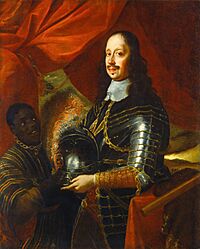Mattias de' Medici facts for kids
Quick facts for kids Mattias de' Medici |
|
|---|---|

Portrait by Justus Sustermans, c. 1660
|
|
| Governor of Siena | |
| Predecessor | Leopoldo de' Medici |
| Successor | Francesco Maria de' Medici |
| Born | 9 May 1613 Florence, Tuscany |
| Died | 11 October 1667 (aged 54) Siena, Tuscany |
| Burial | The Basilica of San Lorenzo |
| House | Medici |
| Father | Cosimo II de' Medici, Grand Duke of Tuscany |
| Mother | Maria Maddalena of Austria |
| Religion | Roman Catholicism |
Mattias de' Medici (born May 9, 1613 – died October 11, 1667) was an important member of the famous Medici family in Florence, Tuscany. He was the third son of Grand Duke Cosimo II and Maria Maddalena of Austria. Mattias was known for being the Governor of Siena for many years. He never married.
Contents
Mattias de' Medici's Life Story
Mattias first thought about becoming a priest, like his brother Gian Carlo. But he soon realized this was not the right path for him. Instead, at just 16 years old, he decided to become a soldier.
His father, Cosimo II, passed away in 1621. Mattias's older brother, Ferdinando de' Medici, became the new Grand Duke. In 1629, Grand Duke Ferdinando chose Mattias to be the governor of Siena. This happened after their aunt, Caterina de' Medici, who was the previous governor, died.
Mattias arrived in Siena on August 27, 1629. He quickly became very popular with the people of Siena. He spent most of his time there. In 1631, he joined the Austrian army during the Thirty Years' War. This was a big war that involved many countries in Europe. Mattias even fought in the famous Battle of Lützen in November 1632. There, he met a general from Siena named Ottavio Piccolomini.
Returning to Tuscany and Military Leadership
Mattias came back to Tuscany in 1641 and took up his role as governor of Siena again. However, he did not stay long because the Wars of Castro began. These were conflicts involving the Pope and various Italian states.
Grand Duke Ferdinando II put Mattias in charge of all military matters for Tuscany. This meant Mattias led the armies of several important states. These included the Republic of Venice, the Grand Duchy of Tuscany, the Duchy of Parma, and the Duchy of Modena and Reggio. They were fighting against the Pope's family, the Barberini. While Mattias was away leading the army, his brother, Cardinal Leopoldo de' Medici, took over as governor of Siena.
A Patron of Arts and Sciences
Mattias loved art very much. He supported many famous artists, such as Justus Sustermans and Volterrano. He also enjoyed horse races and was a big fan of the famous Palio race in Siena. He helped make the Palio popular in its early days.
During his time in Germany, Mattias collected many scientific tools. These included special clocks, tools to study stars (astrolabes), and compasses. He later donated all these valuable items to the Uffizi Gallery in Florence.
Later Life and Legacy
In his later years, Mattias suffered from a painful condition called gout. He thought about becoming a priest again. However, he became very ill and passed away in Siena on October 11, 1667, at the age of 54. He was buried in the Medici family tombs at San Lorenzo in Florence.

